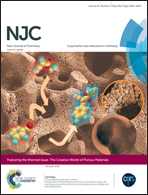Insights into the pore structure of KIT-6 and SBA-15 ordered mesoporous silica – recent advances by combining physical adsorption with mercury porosimetry†
Abstract
We have performed a systematic study of N2 adsorption at 77 K and Hg porosimetry experiments at 298 K on highly ordered KIT-6 and SBA-15 silicas exhibiting noticeably different pore structures with pore diameters in the 7–11 nm range. Accurate pore structure analysis was performed by applying appropriate NLDFT methods to the N2 physisorption data. Mercury intrusion/extrusion experiments on KIT-6 silicas (up to 415 000 kPa) showed no collapse of the pore structure quite remarkably. To the best of our knowledge, this is the first successful example of Hg porosimetry on KIT-6 materials. Hence, it was possible to utilize KIT-6 mesoporous molecular sieves for quantitatively testing the validity of the Washburn equation applied to mercury intrusion for pore size analysis. KIT-6 silicas also allowed investigating the analogies between condensation/evaporation mechanisms of wetting (N2 at 77 K) and non-wetting (Hg at 298 K) fluids as a function of the pore size confirming the thermodynamic consistency between Hg intrusion/extrusion and capillary evaporation/condensation. Contrary to KIT-6 silicas, Hg porosimetry experiments on SBA-15 materials of identical pore diameters show an inconsistent behavior in a sense that both reversible Hg intrusion/extrusion data and partial collapse of the pore structure were observed. Our work clearly demonstrates that combining advanced physical adsorption and Hg porosimetry studies provides a more thorough understanding of textural features and shed some light on the fundamental questions concerning the effect of confinement on the phase behavior of wetting and non-wetting fluids.

- This article is part of the themed collection: The Creative World of Porous Materials

 Please wait while we load your content...
Please wait while we load your content...